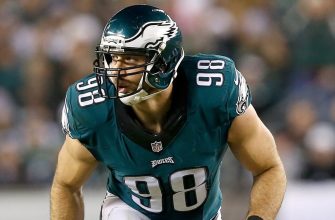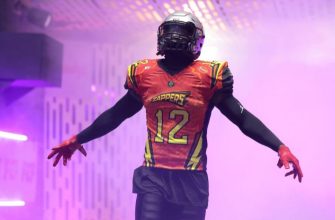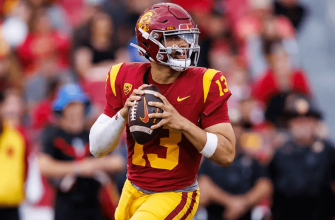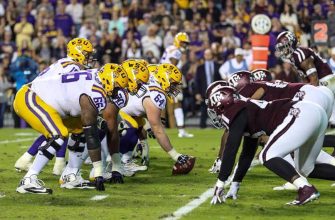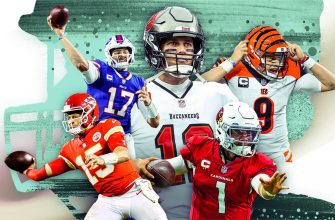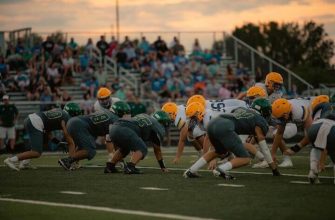The quarterback (QB) sneak is a common football play used to pick up a few yards, typically on third or fourth down and short. It involves the quarterback quickly taking the snap and plunging forward behind the offensive linemen.
The goal of the QB sneak is for the quarterback to quickly thrust ahead and reach the first down marker before the defense can react and stuff the play. When executed properly, it allows the quarterback to pick up a new set of downs with minimal risk of losing yardage or turning the ball over.
The main elements of a QB sneak include:
- The quarterback lines up directly under the center, closer than in a typical play. This allows for a quick snap and handoff.
- The quarterback receives the snap and immediately crouches low, hiding the ball from view.
- The offensive line fires out low, attempting to surge ahead for a yard or two while the quarterback follows right behind them.
- The quarterback plunges forward with their shoulders down, using their legs to drive and push the pile.
The QB sneak is commonly used when the offense needs less than 2 yards for a first down or touchdown. The close formation makes it difficult for the defense to see the ball and react quickly. Due to the quarterback’s vulnerable position, coaches typically only call this play when the distance required is very short. Overall, the QB sneak relies on timing, leverage, and sheer force to pick up a few tough yards on demand.
When Is It Typically Used?
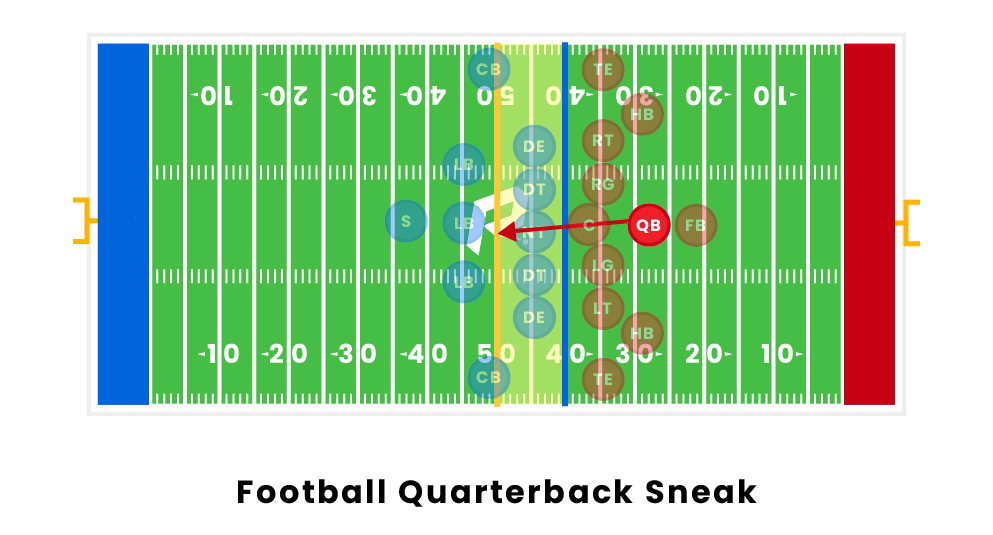
The quarterback sneak is a play typically used in short yardage situations, when the offense only needs to gain a yard or two for a first down or touchdown. The QB sneak relies on the element of surprise and a quick push forward to eke out a short gain, so coaches tend to save it for key situations.
Some of the most common scenarios when a quarterback sneak would be called:
- 3rd or 4th down with 1 yard to go. The quarterback sneak is a favorite in these short yardage situations to pick up a fresh set of downs. Rather than run a standard running play, the QB sneak can catch the defense off guard.
- At the goal line. With the field compressed close to the end zone, a QB sneak can often surprise the defense and result in a touchdown from a yard or two out.
- End of game with the lead. When a team is trying to run out the clock with a narrow lead in the 4th quarter, the QB sneak is an ideal play. The quarterback can minimize risk of a fumble while keeping the clock running with a quick surge forward.
The element of surprise is key – defenses will stack the line of scrimmage in obvious running situations, so the QB sneak can often catch them off balance and result in a key first down or touchdown in short yardage.
Famous QB Sneaks
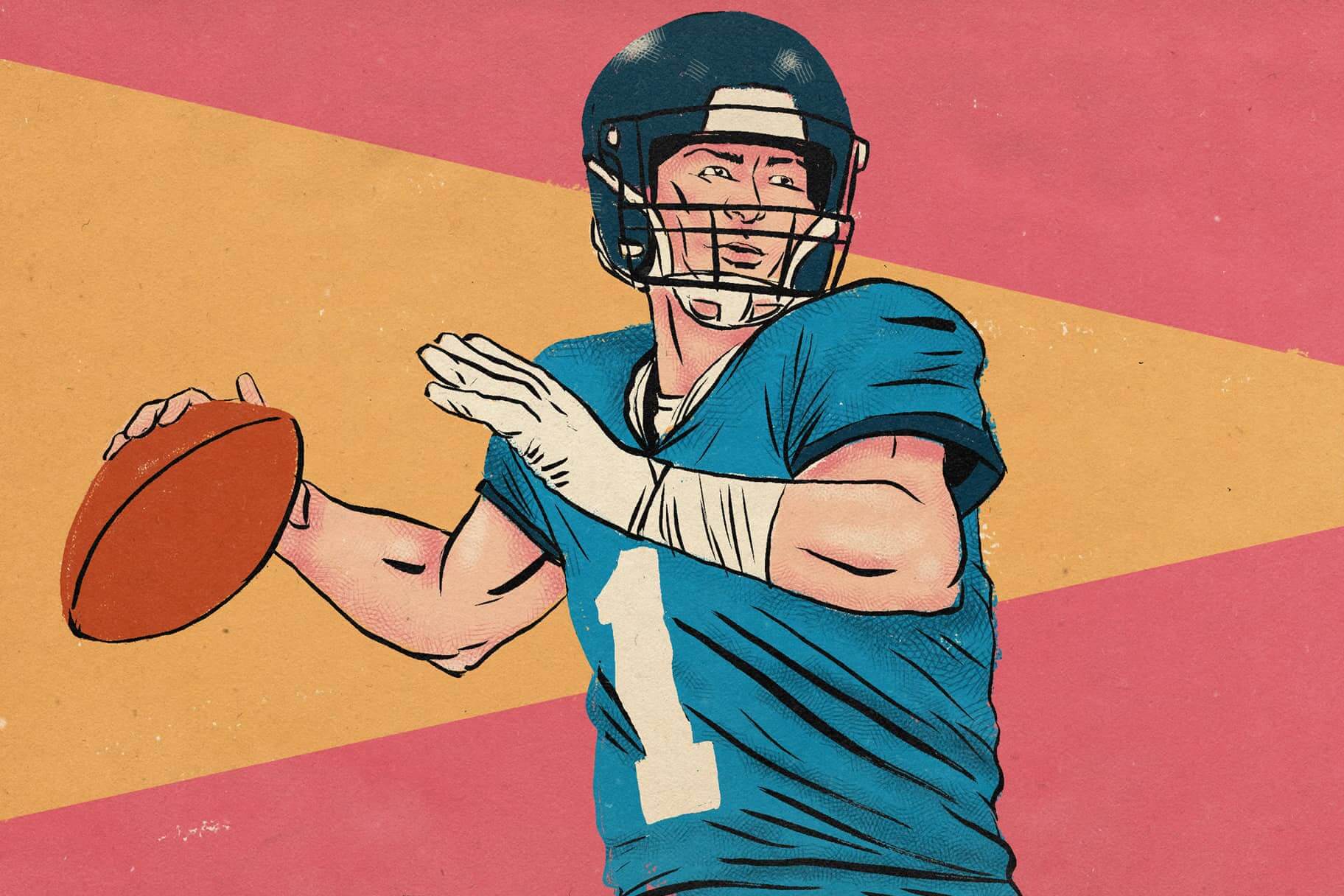
Some of the most iconic plays in football history have come via the quarterback sneak. When a game is on the line late in the fourth quarter, it’s not uncommon for coaches to call on their quarterback to pick up a few inches on a sneak.
Here are some of the most famous sneaks in NFL history:
- In the 1984 Orange Bowl, Boston College trailed Miami 45-41 with 6 seconds left when Doug Flutie called his own number and snuck into the end zone for the game-winning touchdown. Flutie’s sneak capped off his legendary Hail Mary touchdown pass earlier in the game and cemented his 1984 Heisman Trophy.
- In Super Bowl XXXVI in 2002, the New England Patriots trailed the St. Louis Rams 17-10 with 1:21 left in the game. On 4th down from the Rams’ 30 yard line, Tom Brady snuck up the middle for a first down that kept the drive alive. Three plays later, Adam Vinatieri kicked the game-tying field goal to send the game into overtime, where the Patriots won their first Super Bowl.
- Ben Roethlisberger used a QB sneak to convert a crucial fourth down late in the fourth quarter of Super Bowl XL. The conversion led to the Steelers’ game-winning touchdown.
- Doug Flutie had one of the most famous QB sneaks ever in a 1984 game against Miami. With BC down 45-41, Flutie called his own number, snuck into the end zone and scored the game-winning TD as time expired.
Advantages of a QB Sneak
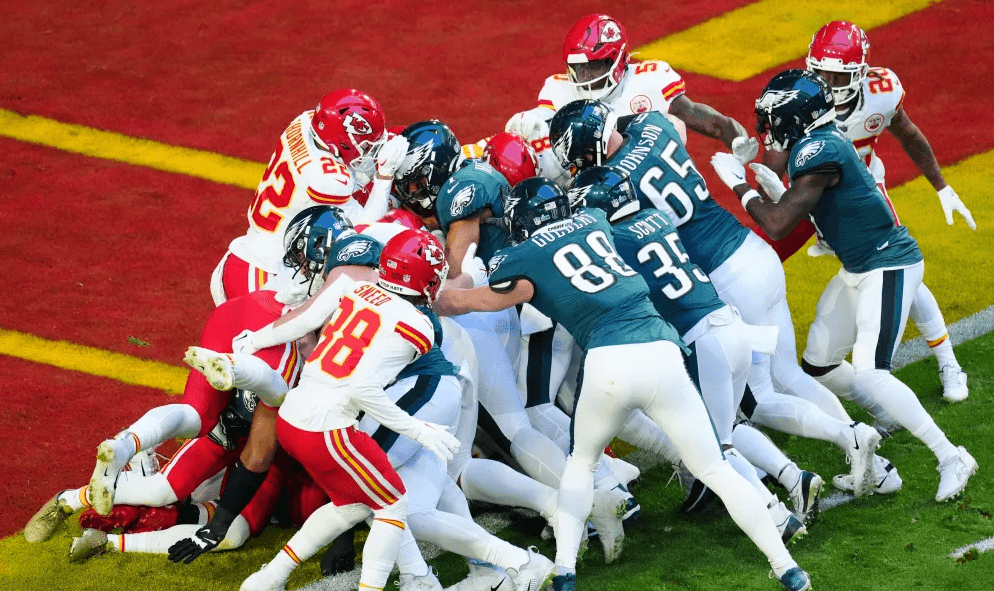
The quarterback sneak has several key advantages that make it an effective play in short-yardage situations:
- High success rate – Statistically, the QB sneak has a very high rate of success in gaining the necessary yardage, with the ball carrier typically only needing to gain 1-2 yards at most. Success rates of 70% or higher are common for QB sneaks.
- Element of surprise – When executed properly, the QB sneak relies on catching the defense off guard right at the snap. The QB immediately ducks down and hides the ball at the start of the play, making it difficult for the defense to react in time to stop the surge forward.
- Hard to stop – With the QB exploding forward and offensive linemen collapsing inward, the sneak makes it challenging for defenders to plug gaps and keep the ball carrier from falling forward for the needed yardage. The QB also has the option to push ahead or follow behind one of the lead blockers up the middle.
Disadvantages of a Quarterback Sneak
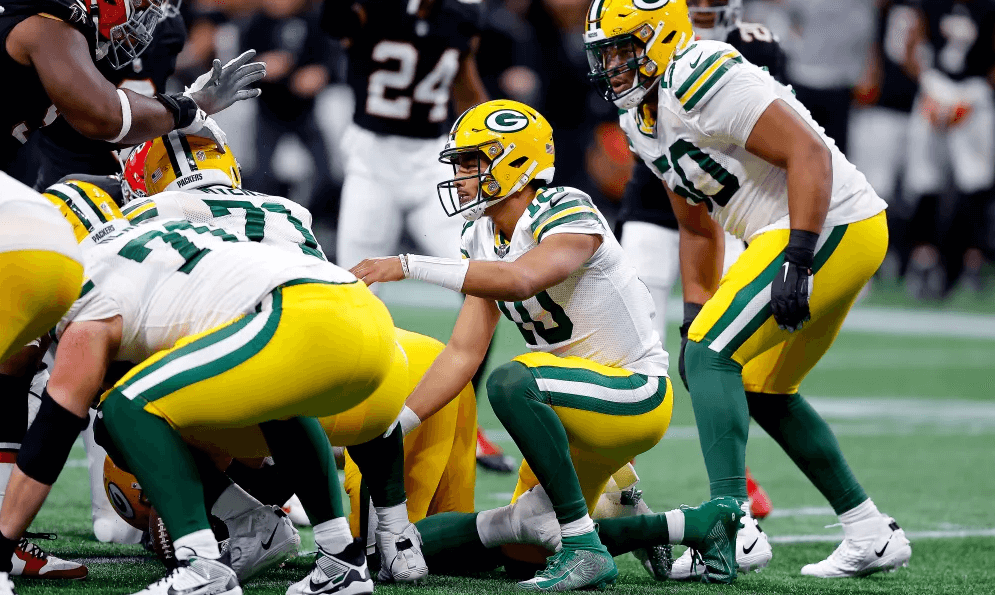
A quarterback sneak does carry some risks and downsides compared to other quarterback rushing plays. Two key disadvantages stand out:
Risk of Injury
Because the quarterback has to plunge forward right into the heart of the defense, a QB sneak brings a higher risk of injury. Defensive players are typically waiting right over the ball and can deliver hard hits on the quarterback as soon as they start their sneak. This dangerous territory for the QB can sometimes lead to injures if a defender lands a big hit while the quarterback is vulnerable. Teams with injury prone quarterbacks may avoid sneaks more often to reduce this risk.
Less Deception
A QB sneak also lacks some of the deception and misdirection elements of other quarterback running plays like bootlegs or scrambles. Because it happens so quickly, the defense has less trouble reading the play and reacting since they know exactly what to expect with the quarterback plunging ahead. The straightforward nature limits its use as a deceptive play compared to fakes or roll outs that can catch defenses off guard.
Key Techniques for the QB
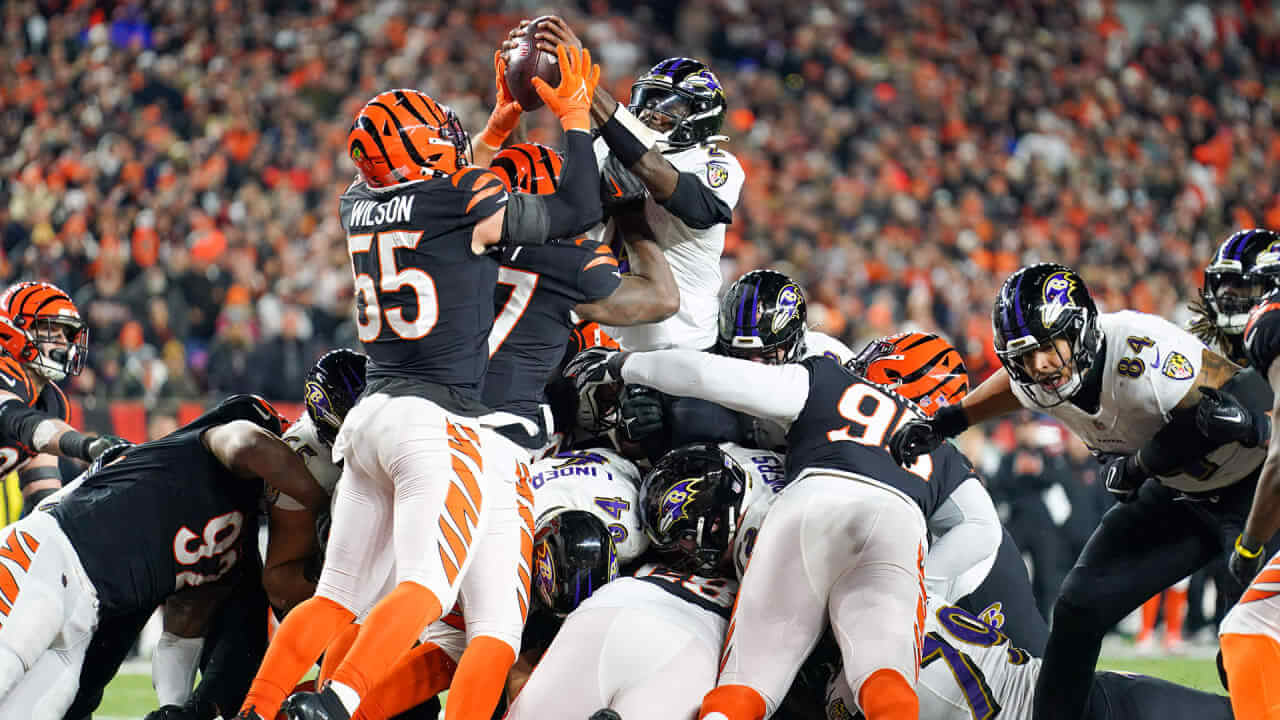
The quarterback sneak requires precise execution and technique to be successful.
Here are some of the key techniques for the quarterback:
Footwork
- The QB needs quick, nimble footwork to burst forward and pick up the necessary yardage. He wants to stay on the balls of his feet and drive off his back foot to surge ahead.
- Keeping a low center of gravity allows the QB to stay balanced through contact. Bending at the knees helps prevent falling backwards.
- Choppy, rapid footsteps help the QB push the pile and drive his legs to pick up extra yards after contact.
Ball Security
- The QB keeps two hands firmly on the ball, tucked tight to his body, as he’s often hit head-on.
- If wrapped up, the QB keeps his elbows in and covers the ball with both forearms. He keeps his shoulders lowered and avoids exposing the ball.
- Once stood up, the QB keeps the ball pinned to his chest or ribs and keeps his feet moving to avoid losing control.
Following Blockers
- The QB identifies the point of attack and aims to follow his blockers through the hole. He doesn’t freelance.
- Keeping his eyes up, the QB reads the leverage and aiming point of the lead blocker(s) to know which gap to target.
- The QB is patient setting up blocks but explodes when he sees a crease start to open. Timing and decisiveness are key.
How Defenses Try to Stop It
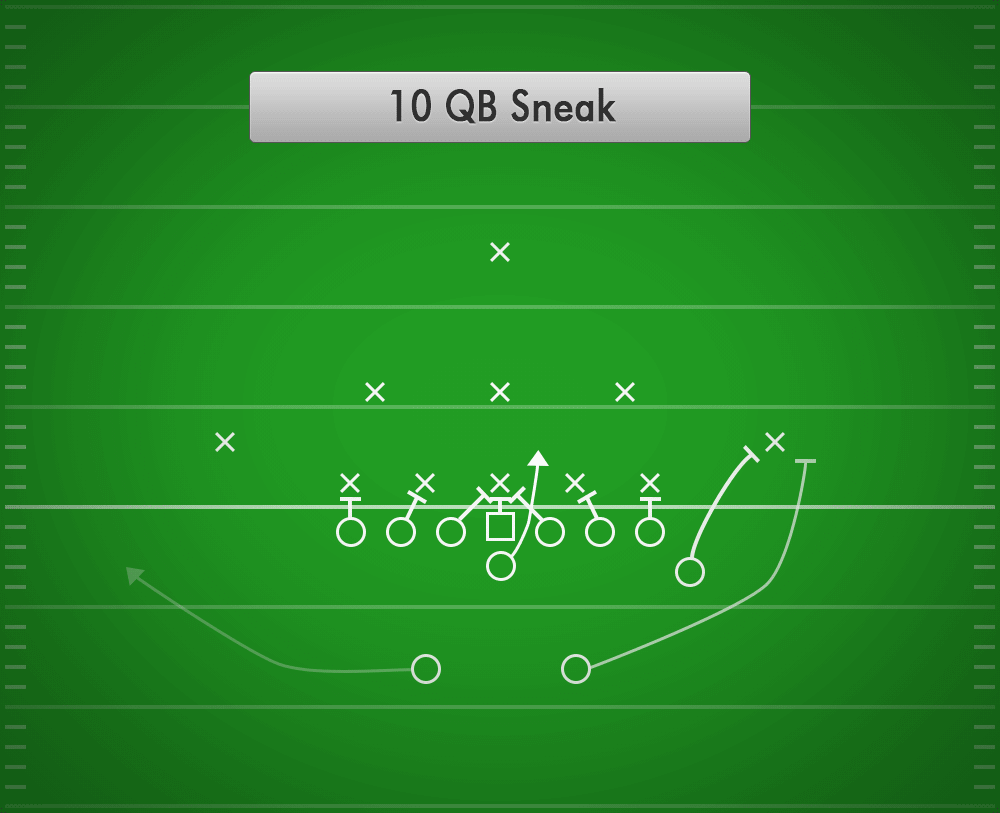
Defensive coordinators have a number of strategies they can employ to limit the effectiveness of a quarterback sneak. Two of the main ways are by stacking the box and hitting the gaps.
Stacking the Box
One tactic defenses use is to stack the box by bringing more players close to the line of scrimmage. This allows the defense to clog any holes that might open up and make it more difficult for the quarterback to find space to sneak through. By stacking large, powerful defensive linemen and linebackers in the gaps, the defense makes it physically challenging for the quarterback to push forward for the first down.
The defense might substitute in bigger players just for the short-yardage situation, trading speed and agility for size and power in an attempt to stonewall the quarterback sneak. Stacking the box presents the offense with a numbers disadvantage and dares them to try and run straight ahead into the teeth of the defense.
Hitting the Gaps
In addition to stacking the box, defenses will try to hit any gap the quarterback sneaks through aggressively. Defenders will stay disciplined in their assignments and be prepared to burst through gaps and meet the quarterback behind the line of scrimmage.
Linebackers and safeties may creep up close behind the defensive line, allowing them to fly through holes and swamp the quarterback before he can get going. Defenders are taught to ignore ball fakes and zero in on their assigned gaps, trying to force their way into the backfield and hit the quarterback for no gain or even a loss.
By stacking the box and aggressively hitting gaps, defenses can often blow up quarterback sneaks and keep offenses from picking up easy short-yardage conversions. The quarterback has little room to improvise, and the athleticism mismatch that usually favors mobile QBs is neutralized by the defense’s numbers advantage through stacking the line of scrimmage. Executed well, these tactics can render the sneak mostly ineffective.
Famous Players Known for QB Sneaks

The quarterback sneak requires perfect timing and finesse to execute effectively. Throughout NFL history, some of the game’s greatest quarterbacks have mastered the art of the QB sneak.
Tom Brady
Tom Brady is perhaps best known for his game-winning QB sneak in the 2001 AFC Divisional Playoff game against the Oakland Raiders. With less than 2 minutes left, Brady snuck up the middle on 4th down to pick up the first down that would set up the eventual game-winning field goal. Brady has converted countless critical short-yardage situations with QB sneaks throughout his career.
Peyton Manning
Although not the most mobile quarterback, Peyton Manning was highly effective with QB sneaks. His 6’5″ height gave him an advantage on sneak plays as he could easily reach over the top of his offensive line. Manning used the QB sneak often in short yardage and goal line situations.
Drew Brees
At just 6’0″, Drew Brees is one of the shorter starting quarterbacks in the NFL. However, his quick feet and timing make him highly adept at QB sneaks up the middle. Brees is especially skilled at sliding into spaces in the defensive line at the perfect moment to pick up the first down or touchdown.
The quarterback sneak requires split second timing and vision to find the slim openings. All-time greats like Brady, Manning, and Brees have mastered the technique to convert critical short-yardage situations. Their proficiency with the sneak makes them some of the most feared players in QB sneak situations.
Notable Rule Changes
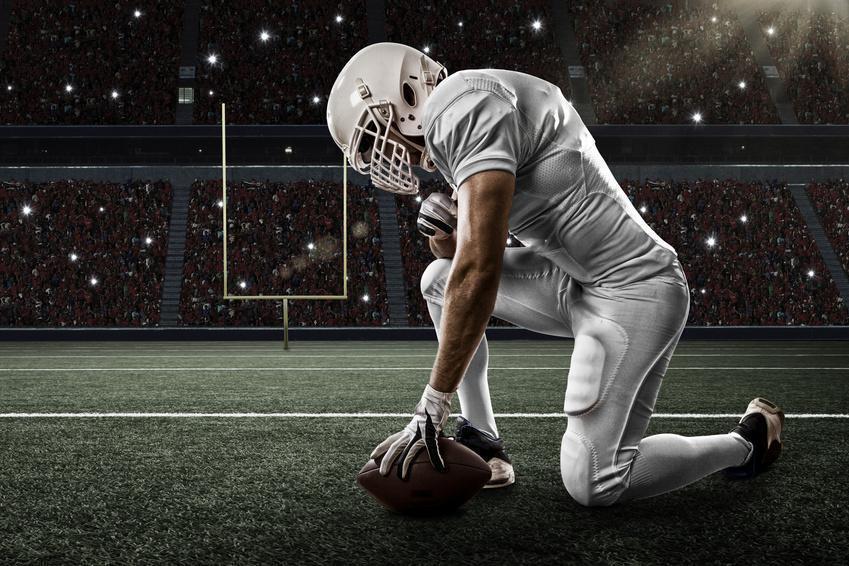
In recent years, the NFL has implemented some minor rule changes that impact the quarterback sneak play. In 2018, the league adopted a new rule that made it illegal for an offensive player to lower his head to initiate contact with his helmet. This was primarily aimed at protecting players from concussions when initiating collisions, like when a running back lowers his helmet to break through tackles. However, it also applies to QBs attempting to dive forward on a sneak play. QBs can no longer lead with the crown of their helmet, and this makes the classic diving sneak over the top more dangerous and less common.
Defenders are also restricted in how they can hit or tackle the QB on sneaks. They cannot land on the QB with their full body weight after he has started his slide. Additionally, the “Carson Wentz rule” implemented in 2020 prohibits defenders from tackling a QB at or below the knees after he has clearly given himself up. This provides extra protection for QBs who decide to duck their head and dive forward on sneak plays. While referees are still allowing QBs to take hits when stretching for the goal line, repeated blows to the helmet are being flagged more often.
Overall, the recent rule changes around initiating contact have reduced the number of big collisions on sneaks but have not eliminated the play altogether. QBs must be more careful in how they execute sneaks now to avoid dangerous hits and penalties.
The Future of the QB Sneak
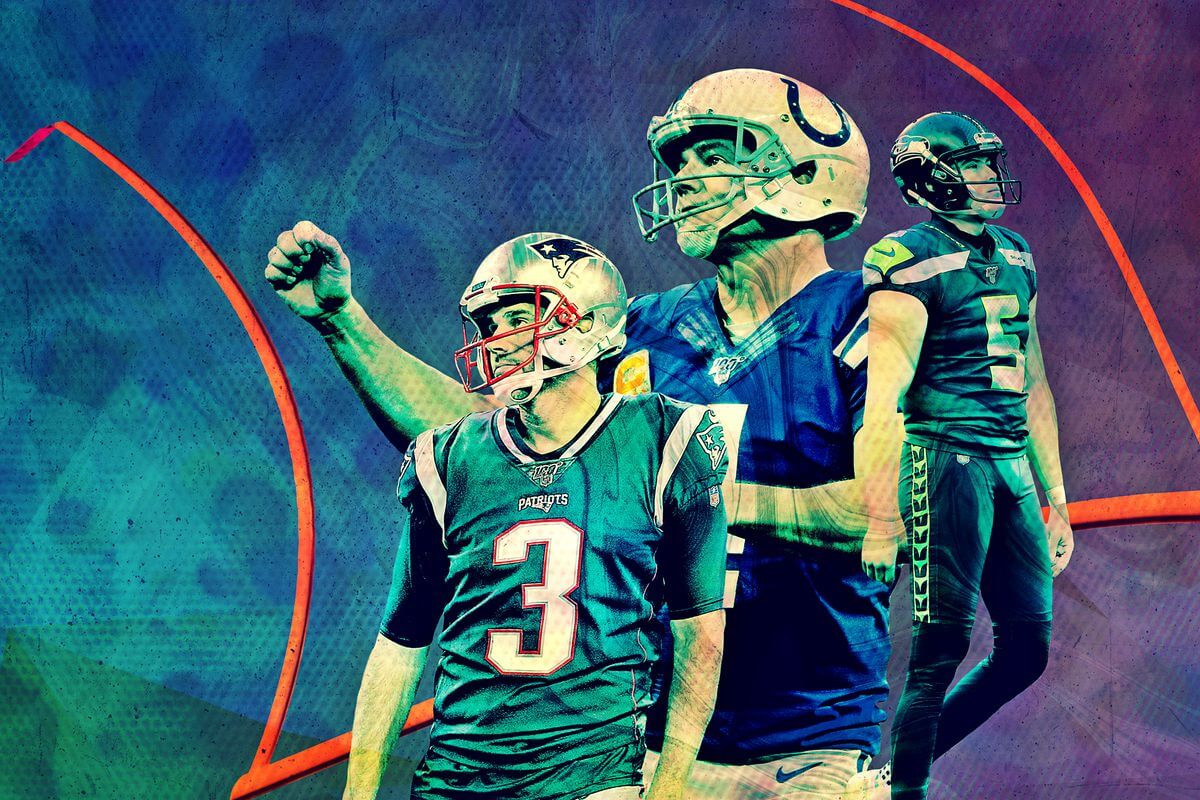
The quarterback sneak has been an effective play for decades, but will it remain viable in the future?
Here are some thoughts on the evolution of the QB sneak:
- Defenses are getting faster and more complex, making it harder to simply push the pile and pick up a few yards. Defensive schemes are focused on shutting down inside runs and often put extra defenders near the line on short-yardage downs. This crowding of the box could require adjustments from offenses.
- Rule changes aimed at improving player safety, like banning wedges on returns or crackback blocks, could eventually impact short-yardage plays like the QB sneak. If dangerous pile-pushing mechanics become more regulated, offenses may need to adapt.
- As passing volume increases across the league, QB sneaks could become a less-utilized tactic over time. However, sneaks will likely remain situational weapons in key moments when offenses need a near-guaranteed conversion.
- Innovation around run/pass option plays gives QBs more decision-making authority at the line. This could lend itself to more QB sneaks, as the QB reads the defense and chooses to sneak.
- Larger mobile QBs who thrive at power rushing, like Cam Newton, can transform the sneak from a pure finesse play into a powerful weapon. The athleticism of modern QBs expands the dimensions of the sneak.


